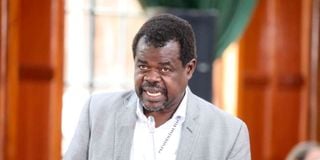Premium
IEBC ‘cooked up’ turnout to hand Ruto a win, court told

Busia Senator-elect Okiya Omtatah who on September 2, 2022 submitted at the Supreme Court that the presidential election result figures were worked backwards to ensure Dr Ruto attained the required threshold.
Shifting voter turnout declared by the electoral agency has turned into a major issue in the presidential petitions as it casts doubt on whether President-elect William Ruto attained the 50 per cent plus one for an outright win.
Petitioners in the case Friday insisted that the Independent Electoral and Boundaries Commission (IEBC) ‘cooked’ figures by mysteriously coming up with a strange formula to arrive at the number of voters in the August 9 presidential election.
IEBC chairman Wafula Chebukati had first announced a 65.4 per cent turnout at the Bomas of Kenya and indicated that the number was set to go up after factoring in voters captured manually before he corrected the figures downwards to 64.767 per cent. The commission is also on the spot for using different numbers other than the gazetted number of registered voters to compute the percentage of the turnout.
Voter turnout
Voter turnout is crucial in determining if any of the candidates in the election attained more than a half of the cast votes. On the final day of the hearings, Busia Senator-elect Okiya Omtatah submitted that the figures were worked backwards to ensure Dr Ruto attained the required threshold.
Mr Omtatah said figures show no candidate met the set threshold for a win. “These figures are cooked. They were worked backwards to achieve a certain figure, but, fortunately, in Form 34C, the smoking gun is seen. Since figures don’t lie, if the maths does not add up, then this court should quash the results,” submitted Mr Omtatah.
“I also ask the court to take note of the following absurdity. From the press statement (by Mr Chebukati) … the chairman reported 12,065,803 people voted and this represented 56.17 per cent of the total registered voters of 22, 120, 458,” said Mr Omtatah.
The activist said IEBC’s election director Moses Sunkuli, in his replying affidavit, uses the same number of voters (12,065,803) as reported by the chairman but against a different number of 21,481,652 to arrive at the same percentage.
Magic in figures
“This is the magic in figures this court is faced with. Both give the same voter turnout ratios of 56.17 per cent. Same numerator, different denominator but same results. Absurd in toto,” he adds.
“Voter turnout is the absolute value of the total registered voters participating in an election. Without the absolute value, percentages cannot be assigned to individuals participating in an election. And the absolute value cannot change in relation to anything else,” he submitted.
He argues that IEBC cannot run away from the total number of voters it gazetted in the run-up to the polls. The commission placed the total number of registered voters at 22,120,458 in a Gazette notice.
“The national register of voters is a fixed number. It is not and cannot be a moving target as is the case with using the aggregate voters in Kiems kits as they reported. And it can’t keep on changing until now, as it does in the affidavits of Sunkuli and Chebukati,” he added.
Registered voters
Senior counsel Otiende Amollo, in his submission, said the commission can only use the published number of registered voters as denominator in calculating voter turnout percentage.
The Rarieda MP-elect said that by trying to use 22,005,541 to determine the turnout, the commission created a moving target to attain their pre-determined turnout. “The common denominator to be used is voter turnout as published in the Gazette, not as per the Kiems kit, which ends up with the moving target,” said Mr Amollo.
“By whatever permutation, none of the candidates then, achieved 50 per cent plus one vote, whether you remove or add rejected votes.”
But IEBC lawyer Mahat Somane told the court that Mr Chebukati made a correction of his initial declaration.
Kiems kit
The commission explained that voters authenticated through the Kiems kit were 14,239,862 in 45,994 polling stations, translating into 22,005,541 registered voters.
The commission further explained that the number of voters authenticated using the complementary mechanism (printed register) in 229 polling stations were 86, 889.
Mr Somane also discounted claims that a total of 1.6 million voters cast their ballot way after the polls closed. He said the kits were delayed to transmit their results because of lack of network. He said the votes could have been transmitted from areas with no network coverage.
The commission says the final voter turnout used to declare the presidential results was 64.767 per cent. These were the voters identified using both the physical printed register and the Kiems kits in all the 46,229 polling stations. Total valid votes were 14,213,137, with the total rejected votes at 113,614.





